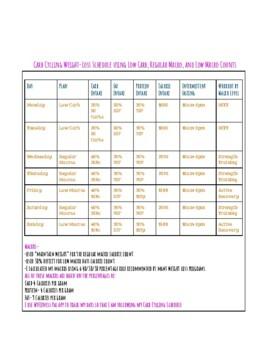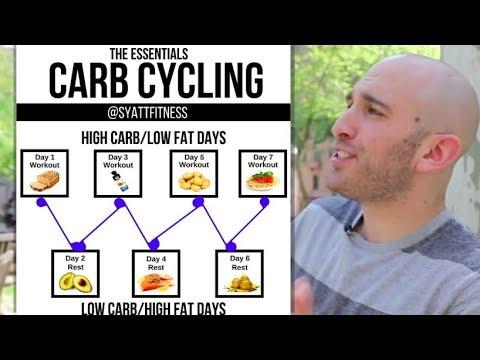In the ever-evolving landscape of dietary strategies, carb cycling has emerged as a compelling approach for those seeking effective weight loss without sacrificing metabolic health or muscle mass. As a method that strategically alternates between high and low carbohydrate intake, carb cycling is designed to optimize the body’s hormonal responses, boost metabolic rate, and enhance fat utilization. This article delves into the intricacies of carb cycling, providing a detailed analysis of its mechanisms and efficacy. By examining scientific studies and expert insights, we aim to equip you with a comprehensive understanding of how to implement carb cycling into your weight loss regimen, ensuring a balanced approach to achieving your health goals with confidence and precision.
Understanding the Science Behind Carb Cycling
Carb cycling is a dietary approach that strategically alternates between high-carb and low-carb days to optimize metabolic flexibility and energy expenditure. At its core, this method leverages the body’s natural hormonal responses to carbohydrate intake, particularly insulin, to enhance fat burning and muscle preservation. By varying carb intake, the body is encouraged to utilize different energy pathways, preventing metabolic slowdown and enhancing the efficiency of weight loss efforts.
Key Scientific Principles:
- Insulin Sensitivity: On high-carb days, increased insulin levels promote glycogen storage in muscles, which can enhance performance and recovery. This is crucial for maintaining muscle mass during weight loss.
- Fat Oxidation: Low-carb days promote the use of stored fats as a primary energy source, facilitating fat loss while minimizing muscle catabolism.
- Metabolic Adaptation: The variation in carb intake helps prevent the body’s metabolism from adapting to a single dietary pattern, thus maintaining a higher metabolic rate.
Understanding these principles allows for a more tailored approach to dieting, aligning with individual goals and activity levels to maximize results.

Creating a Personalized Carb Cycling Plan
Designing a customized carb cycling plan involves tailoring the approach to fit your unique lifestyle, dietary preferences, and fitness goals. Start by determining your daily caloric needs and macronutrient ratios, keeping in mind that your protein intake should remain consistent while your carbohydrate intake fluctuates. Consider incorporating high-carb days on your most intense workout sessions to fuel performance and recovery, while reserving low-carb days for rest or light activity.
Key elements to consider when crafting your plan include:
- Meal Timing: Schedule your carb intake around workouts for optimal energy utilization.
- Portion Control: Use portion sizes to manage caloric intake, especially on low-carb days.
- Food Choices: Focus on whole, nutrient-dense carbs like sweet potatoes and quinoa.
- Hydration and Supplements: Ensure adequate water intake and consider supplements like electrolytes to support energy levels.
By adhering to these principles, you’ll be better equipped to leverage carb cycling effectively for weight loss while maintaining muscle mass and enhancing overall well-being.

Balancing Macronutrients for Optimal Results
Carb cycling is an innovative approach that strategically alternates carbohydrate intake to help you achieve your weight loss goals without compromising energy levels or muscle mass. The key lies in understanding the balance between your macronutrients: carbohydrates, proteins, and fats. By manipulating these elements, you can effectively enhance your body’s metabolic rate and fat-burning capacity. On high-carb days, you fuel your workouts and replenish glycogen stores, promoting muscle growth and recovery. In contrast, low-carb days are designed to push your body into a fat-burning mode, leveraging stored fats for energy.
- High-Carb Days: Focus on complex carbohydrates like quinoa, brown rice, and sweet potatoes to sustain energy.
- Low-Carb Days: Prioritize lean proteins and healthy fats, such as avocados, nuts, and olive oil, to keep satiated.
- Moderate-Carb Days: Balance your intake with a mix of proteins, fats, and moderate carbs for maintenance.
By effectively cycling these macronutrients, you can maintain a caloric deficit for weight loss while preserving muscle mass and preventing the metabolic slowdown often associated with traditional dieting. This nuanced approach allows for flexibility and personalization, making it a sustainable option for many individuals.

Monitoring Progress and Adjusting Your Strategy
As you embark on your carb cycling journey, it’s crucial to keep a keen eye on your progress to ensure that you’re moving towards your weight loss goals. Begin by tracking your daily intake of carbohydrates, proteins, and fats, using apps or journals to maintain accuracy. Regularly assess your energy levels, workout performance, and overall mood, as these can provide valuable insights into how your body is responding to the dietary changes.
- Evaluate Weekly: Dedicate time each week to review your progress. Consider factors like changes in body measurements, weight fluctuations, and how your clothes fit.
- Adjust Macronutrients: If progress stalls, you may need to tweak your macronutrient ratios. For instance, consider increasing your protein intake on low-carb days to help maintain muscle mass.
- Incorporate Feedback: Pay attention to what your body tells you. Feeling sluggish? You might need more carbs on certain days to boost energy and performance.
- Seek Professional Guidance: If unsure, consulting with a nutritionist or dietitian can provide personalized advice to refine your strategy.
By actively monitoring these elements and making informed adjustments, you can optimize your carb cycling approach for effective and sustainable weight loss.
